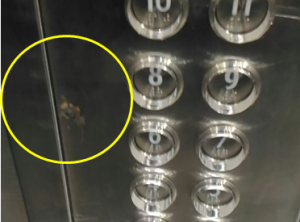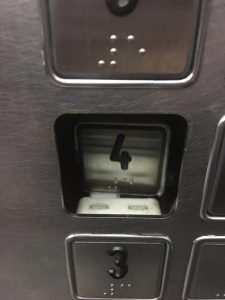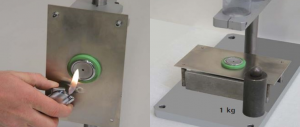Faulty Control Operating Panel (COP)
Loose COP cover
- Causes
The panel is not securely screwed to the interior wall of the car
- Description of defect
Foreign material is stuck in between the panel cover and the substrate. This shows that the panel are loose, and not completely enclosed leaving gap in between.
This gap will allow any foreign material, debris, and dust to trap inside the gap which will clogged the button, and later causing faulty to the destination floor button.

Presence of trash in the elevator car panel
Dislodged of floor buttons from COP
- Causes
Wear and tear and misuse by users
- Description of defect
The common defects of elevator car buttons are when they dislodged from the car panel. This is normally due to wear and tear and misuse by the users. For instance, passengers are likely to press the door close button repeatedly as thought that the doors will close faster.
In contrast, it may cause the doors to close sooner and when the door buzzer sound, it will indicate the doors will start closing. Defects of elevator buttons also can be caused by wrong design, where some of the buttons are highly reflective which will cause difficulty to the passengers to see the floor numbers, especially to the elderly.

Car button dislodged from the panel
- Diagnostic/testing method
Shock testing is conducted by the manufacturers to test the durability of the elevator buttons. The test is done with 1 kg machine and 10 mm circumference. For Class 1, the press head is followed out from the height of 0.2 m while 1 m for category Class 2.
The test model is placed in the holder frame and then dropped. Meanwhile, to check the fire proof, a gas lighter is used in the worst possible angle to examine in the worst possible outcome and be exposed to the flame for 60 seconds for Class 1 and 120 seconds for Class 2.
Lastly, water proofing test is conducted using a spray hose, with an angle from +/- 180 º both sides with maximum distance of 200 mm for 10 minutes (EN 81-71).

Shock and fire testing of elevator call button [25]
- Good practices
EN 81-71 describes measures and security rules about the withstanding protection against vandalism in elevators
- Corrections
For elevators that installed in a scarcely attended public areas such as public housing, urban infrastructures, and social houses, it is recommended to use a vandal resistant certification elevators complying EN81-71 standards.